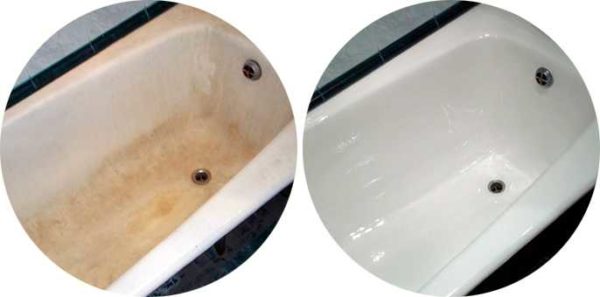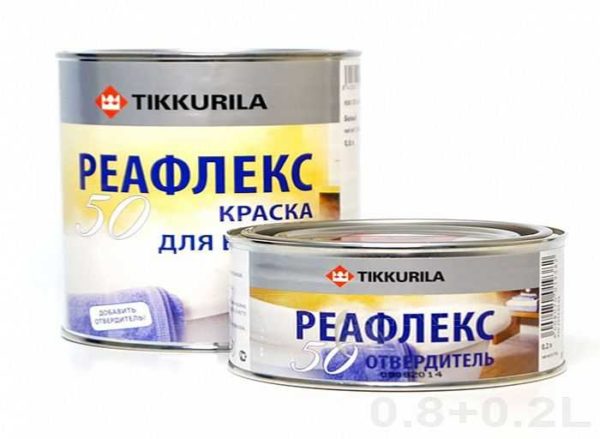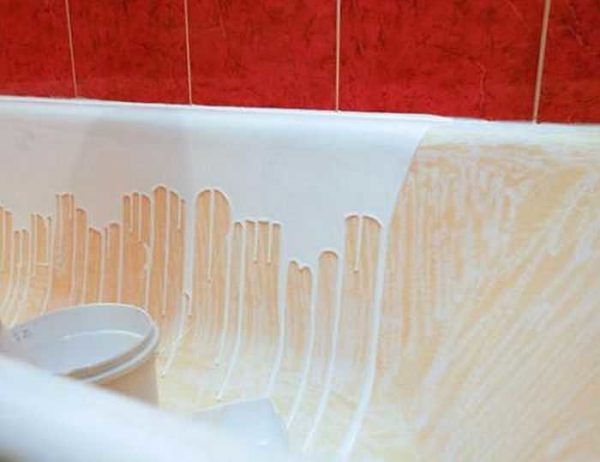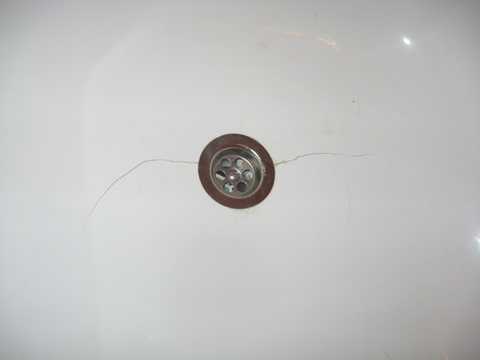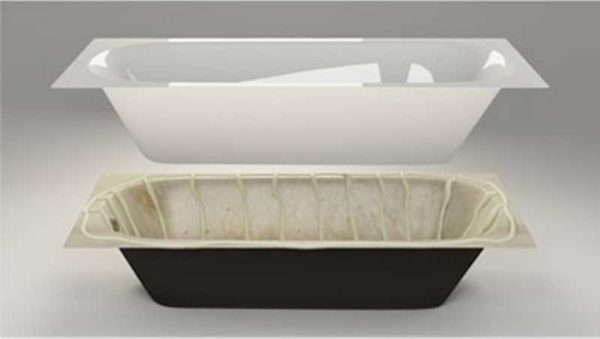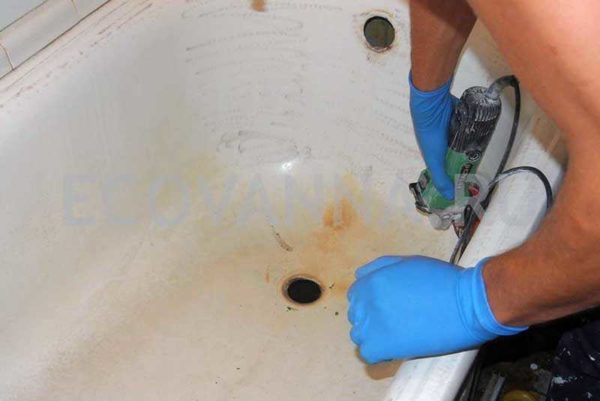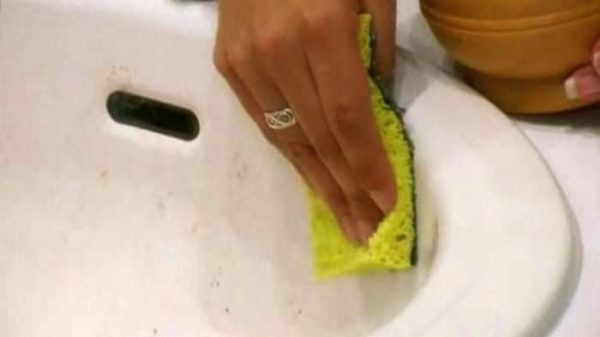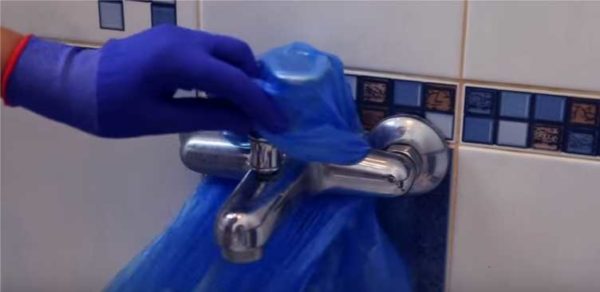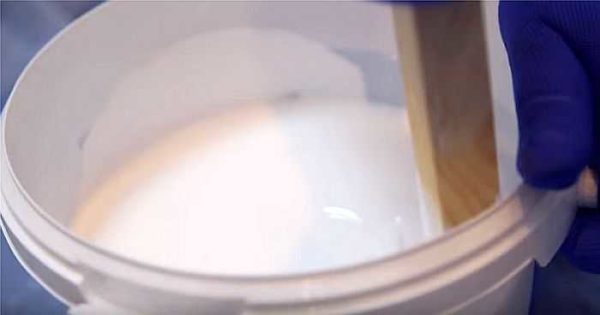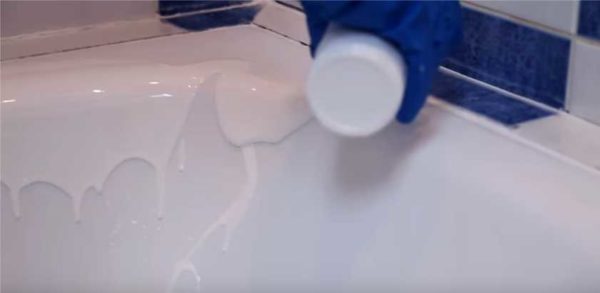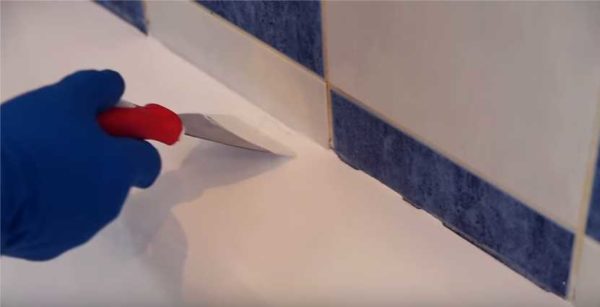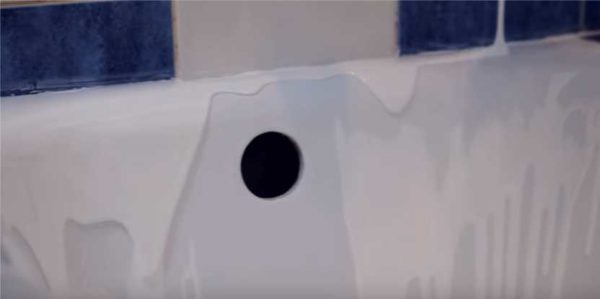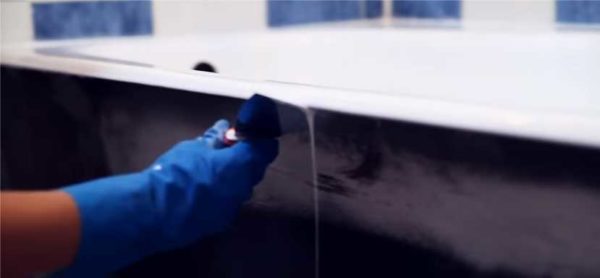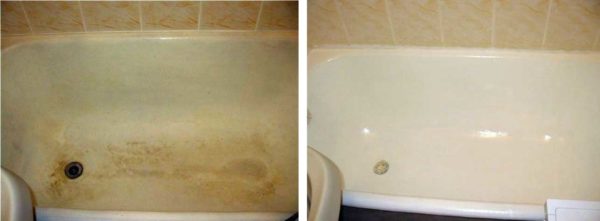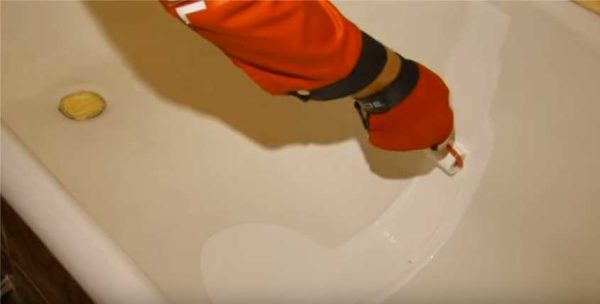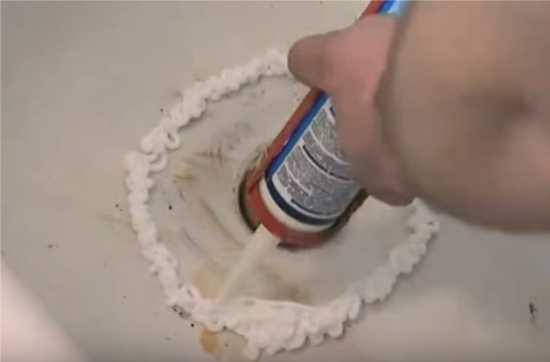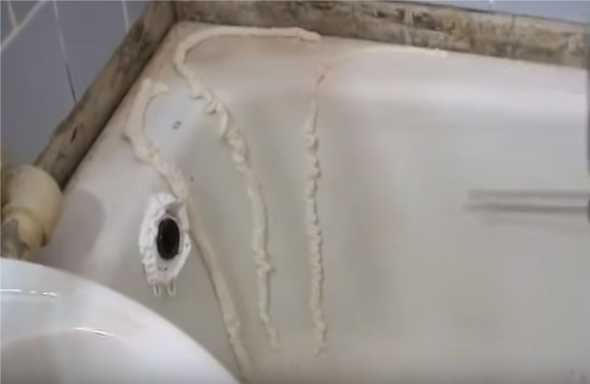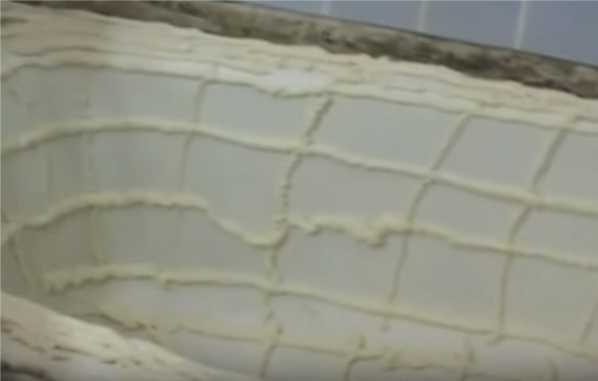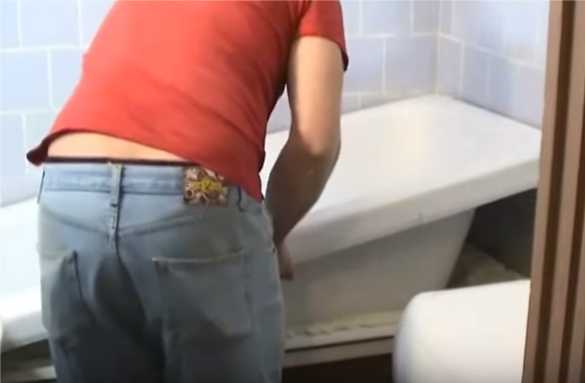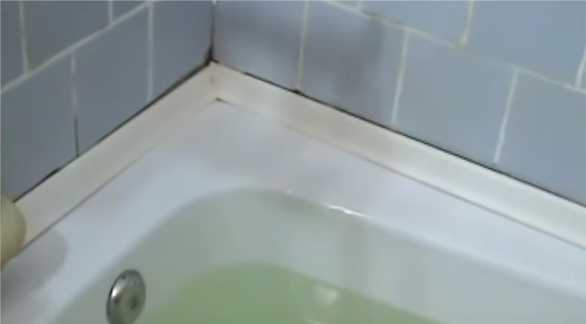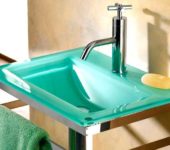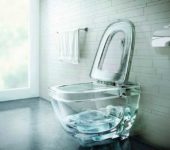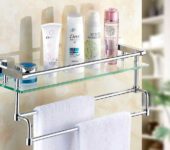How to refurbish a bathtub cover
What to do if the bathtub is already far from presentable, and there is no possibility or desire to put a new one (overhaul when replacing is almost inevitable)? There are several technologies that allow you to make a new one from an old bath - to renew the coating. Bathtub restoration is possible with your own hands, you just need to choose which specific method you will use.
The content of the article
Bath restoration methods, their advantages and disadvantages
Do-it-yourself bathroom restoration can be done in three ways:
- painting with special enamel;
- liquid (bulk acrylic);
- acrylic insert insert (bathtub in the bathroom).
If we talk about independent work, then most often the bath coating is restored with the help of painting or bulk acrylic. It's just that the cost of an acrylic insert is about 80% of the total amount that firms take for this procedure, so rarely anyone wants to understand the intricacies. Also, if you install it yourself, you void your warranty. Nevertheless, using this method, you can update the bath with your own hands.
Enamel painting
Now about the pros and cons of each method. Enamel painting is the cheapest option, but also the most short-lived. Such a coating lasts for several years - from 3 to 5. The specific figure depends on the thoroughness of the preliminary surface preparation and the quality of the paint.
The painting process is not the easiest one - to get a good result, you need to apply several (at least three), and each of them has to “earn extra money”, removing sagging, dripping, smoothing out irregularities. All this takes time and patience. But, as a budget option, the method is not bad. After the paint begins to peel off, it is removed (heated with a construction hairdryer, removed with a spatula) and, after surface treatment, the bath can be painted.
The enamel composition has a very pungent persistent odor that lasts for a long time. It is better to work in a respirator, but it is advisable not to open the doors - the paint will dry faster, it will be more difficult to fix it.
By brands of paint that are used to paint the bathroom. First of all, it is Tikkurila REAFLEX 50 (Tikkurila Reaflex). Two-component enamel. Not cheap, but high quality. Feedback on its use is positive. In principle, the quality of the coating depends on how exactly the proportions are observed when mixing the components. You can't pour anything less, nothing more. It will only get worse.
There are other enamels - organosilicon ones, on which it is written "for baths". Others cannot be used, as they can release harmful substances in contact with warm water.
Bulk bath
Bath restoration with bulk acrylic is becoming more and more popular. It is a two-component formulation that is mixed immediately before use. The cost of the set is about $ 50 (more or less depends on the size of the bowl). As in the previous version, the durability of the coating depends on the quality of the surface preparation. And it should not have any dirt, greasy stains, and the surface itself should be smooth and rough. The process of applying the composition is simple - it is simply poured in a thin stream from a small container, and it is leveled by itself. The layer is thinner on the walls, thicker at the bottom. An ideal state of affairs for operation.If done correctly, such a coating will last up to 5-7 years, although manufacturers say that the service life is more than 10 years, some even talk about 15 years.
In addition to durability, this material also pleases with the absence of odor. Rather, there is a smell, but very weak, almost imperceptible, so it is comfortable to work with it.
About materials that can be used to restore a bathtub at home. There are mainly reviews about two brands: Stakril and PlastAll. Both materials have a good reputation (if done correctly). There are a large number of cheaper brands of liquid acrylic on the market, but rarely have hygiene certificates. And without documents it is better not to risk it.
Bath insert
Plus the "bath in a bath" option in the durability of the coating - up to 15 years, but the warranty is usually given for 2-3 years. However, this method is not so simple either. Installing the acrylic liner is both easier and more difficult at the same time. Firstly, there are so many liners on standard bathrooms, but not everyone has them. Secondly, they cannot be placed on thin-walled metal or made of "light" cast iron - the metal is thin, it walks under load, which is why the insert quickly separates from the base and bursts. Since it is these specimens that have to be restored most often, firms simply “forget” about this moment.
There are three more negative aspects to using the bath-in-bath method. They are not necessarily present, but they can also lead to damage to the liner, so it is advisable to know about them. So, what can negatively affect the life of the acrylic liner in the bathroom:
- The molded insert has an ideal geometry, and the baths, most of all, have deviations. In the places of these inconsistencies, cracks usually form.
- Acrylic sits on a special two-component foam. Although it holds the load better than the construction one, it can still creep. Voids form in these places, and they lead to cracks.
- In the places where the siphon and overflow are installed, two containers are connected. It is very important to carefully seal this joint. Firstly, because water will flow to the floor, and secondly, it can flow into voids, bloom there and spread the appropriate "aromas".
In addition to all the nuances of installation, it is important to choose a quality liner. And this is very difficult. Plumbing acrylic is expensive. Therefore, the inserts are sometimes made very thin or from cheap porous and brittle acrylic, sometimes from fiberglass with spraying.
The thicker the acrylic layer in the liner, the higher the price. In cheap inserts, the thickness is very small - 0.5-1 mm, in average quality 2-3 mm, and it is very difficult to find an insert with 4 mm acrylic, but they are the most durable. When calling companies, be interested in the thickness of the liner at the bottom. If they say that it is 5-6 mm or even more, they deceive you. They just don't do it and there's nothing else to talk about. The second thing to ask about is the presence of a hygiene certificate. Sometimes inserts are molded from counterfeit material, and it is very short-lived - it cracks after a few months. Such a product has no documents, although the "leftists" can also give it. But still ... The next stage of quality control is visual. When visiting a company from which you plan to purchase a plastic insert for the bathroom, inspect a few pieces. They should be perfectly even and the color should be snow white. Not greyish, greenish, or yellowish. Snow white. No shades. In this case, one can hope that the bathroom he has restored will serve for a long time.
Preparation
Bath preparation for restoration is important in any case. Even if you are going to put an insert. There, too, good adhesion (adhesion) to the foam is required. And in the case of using enamel or acrylic, preparation plays a very important role.
If you look at the description of the work of firms engaged in the restoration of bathtubs, then their preparatory stage is to remove the drain and overflow, walk well over the entire surface with sandpaper with abrasive powder, wash and dry. If available, repair the chips with automotive putty. Sometimes it is added that it is necessary to degrease the surface with a solvent. That's all, then enamel is applied or acrylic is poured. All work takes a maximum of 3-4 hours.
When studying reviews about self-restoration, the picture is different - there are much more stages and preparation is often delayed for a day. There are two ways. The first is to remove the top layer with a grinder and petal sandpaper (remove the top layer of enamel, and not clean it to metal). After removing the dust, you can paint.
The second way is to remove contamination with acids, alkalis, solvents. Both methods have been tried and they work equally well. You can choose which is better - dust and sound when processing with a grinder, or smells when processing with chemistry.
Here's what to do before restoring enamel using a chemical cleaning method:
- Remove overflow and siphon, remove dirt that is being removed.
- If the bath has already been restored before, all the material is removed down to the enamel.
- We remove dust and debris with a soft bristle brush (sweep into the drain hole). You can use a vacuum cleaner.
- We take the acidic composition, coat it, keep the time according to the instructions, wash it off (put a basin under the bath - the siphon has already been removed).
- We take an alkaline detergent, you can just baking soda, we thoroughly coat it with it, rubbing it into the surface. We wash it off (don't forget about the basin).
- Dry.
- If there are places where the metal is exposed and rust has emerged, we clean it to a pure metal, process it with a rust converter, wait for the allotted amount of time. Then we align it flush with the enamel with a putty.
- We fill up chips and large cracks with putty. Well suited putty from Novol, universal or with fiberglass. It has a gray color and is not visible from under the cover. It hardens in 10-15 minutes, after which it can be cleaned with sandpaper so that a flat surface is obtained.
- Once again we remove dust and dirt. You can wash and dry again if necessary. If there are cracks in the enamel, they must be dried very carefully - even a small amount of moisture will lead to the appearance of bubbles, which will soon burst. Instead of a flat, smooth surface that is easy to clean, you get lots of holes for dirt to clog.
It's all. Next, enamel or acrylic is applied, an insert is installed.
Applying bulk acrylic
Bathtub restoration with bulk acrylic is perhaps the easiest way to renovate it (though not the cheapest), you just need to know a few subtleties.
The first point concerns the density and temperature of the material. For a normal polymerization process, a temperature of 22-26 ° C is required. In order for liquid acrylic to spread normally, it must stand for at least a day in a warm room. During this time, the composition will pick up the required temperature. There is another option - put it in a bucket or basin with warm water (not hot, but warm). Only in this case there is a possibility of overheating. Then it will be too fluid, the layer on the bathroom will be much thinner than required. So we try to bring it exactly to the required temperature.
The second point is the absence of any drafts. Good craftsmen work indoors. They even sand the enamel with a grinder or treat it with acid. They do it in respirators, which is what we advise you. But they need to hurry, because for them time is money, and the owner has nowhere to rush. If you are doing the restoration of the bathroom cover for yourself, you can do all dusty or "odorous" work with the doors open and ventilation on, then close the doors and wait until the temperature reaches the desired limit of 22 ° C or slightly higher.
The third point is the exclusion of water droplets and dust. While the room is warming up, it is necessary to wrap all the taps with polyethylene, completely excluding the possibility of water ingress. In addition, it is necessary to wrap the shelves, heated towel rail or other devices and objects above the bathroom with cloth. This is to prevent the formation of condensation, drops of which can damage the surface of an uncured filling tank. Also: during operation and polymerization (from two to five days), the doors must be kept closed. This way you maintain the required temperature, and also reduce the possibility of dust, debris and insects getting on the surface. It is very offensive when a midge or a fly land on a beautiful white surface. It is almost impossible to remove it without traces. After complete hardening, you will have to skin and re-fill, but a trace usually remains - there is not enough qualification.
When the temperature in the bathroom has risen to 22 ° C, a film or paper is placed under the outer side of the bathroom, a clean container is placed under the drain hole, into which excess material will be drained. If the bathroom is tiled along the edge so as not to get dirty, it is pasted over with masking tape, making sure that the edge is even.
For further work, you need a regular or rubber spatula about 10 cm wide, a plastic container with a volume of 500-600 ml (a beer glass is suitable). The jar with the acrylic heated to the required temperature is opened, the remains of the acrylic are carefully removed from the lid with a spatula, and sent to the jar. Then the material is also cleaned from the walls. All walls must be clean so that no acrylic remains on them that is not mixed with hardener.
The hardener, which comes complete with acrylic, is poured into the jar, mixed for 15 minutes. You can interfere with a planed wooden stick or a drill attachment at low speeds. It's safer with a stick - guaranteed not to damage the jar or splatter the material. If you decide to use a drill, the nozzle should not have a burr or sharp protrusions, the speed should be the lowest. Work the bottom and edges well when stirring.
Leave the mixed naive acrylic for the bath for 10 minutes, then stir again for 5 minutes. It is necessary to work either without a shirt or in clothes that will not touch the edges of the bathroom.
We put the jar in the bath, take the container, pour the composition into it from the jar. From the glass, we begin to pour onto the side from the far edge of the bathroom, going around it on three sides. The composition slowly flows down, enveloping the surface, and is distributed in an even layer.
It is impossible to pour on the side exactly under the wall, and the edge looks ugly. We take a spatula, carefully distribute the composition, covering the entire surface. He will align himself.
Having spilled three sides along the side, we begin to pour just above the place where the old coating is visible. We pass again on three sides. Usually, two or three passes are enough to cover the entire surface, in some places you can touch up a little with a spatula, directing the material to the right place.
We fill the last side with the last. It starts to drip from it, so work carefully. The process is the same. First at the top, then a couple of times a little lower.
Final touches. Draw a zigzag motion along the bottom of the bathroom with the angle of the spatula. This will help to evenly distribute the composition, to avoid sagging. In conclusion, remove the drops that have hung there with a spatula from the outer edge of the rim (just run the spatula blade along the rim).
The bath is left for 48 hours. After that, you can remove the scotch tape, film, paper that has been spread around. Everything, the restoration of the bath with your own hands is completed, but it will be possible to use it in another three days.
Bath enameling at home
About good compositions for enameling was described above, so it is advisable to use them. The can has instructions for use, but the practical rules are the same as for ordinary painting. Only preparation is unusual, but it has already been written about.
Some firms suggest priming the surface before applying the enamel to the bathtub. If there is such a possibility, it should be done. The primer is applied in the same way as the enamel, after drying (the period is indicated on the can), sanded to smoothness, then cleaned from dust, washed, dried. Then the enamel is applied.
A good natural bristle brush or a small foam roller can be used to spread the composition. So that the bristles do not come out of the brush, soak it in water for a day and take out everything that happens with your hands. There are no problems with the roller.
A hardener is poured into the main composition. Measured exactly according to the recommendation, no more, no less. Stir well, paying special attention to the bottom and sides. When using a roller, some of the enamel is poured onto the bottom of the bathtub - it's easier to work this way. The composition is taken from the jar with a brush. They try to apply the enamel or primer evenly, leaving no unpainted spots or streaks.
After priming, sanding is required, followed by cleaning from dust, and after applying the enamel, you must look at the results. If everything is smooth, you can stop there. If the appearance does not suit you, sandpaper it again. smoothing out irregularities and painting again. Sometimes up to 4 layers are needed.
Self-installation of acrylic liner (inserts)
Bathroom restoration using this technology has its own peculiarity: if the bath rim is tiled, it must be removed. Not the most pleasant moment. Removing the tile can be dispensed with if the bath rim extends from under it by at least 1 cm. Then the liner can be cut along the edge. Cut it with a grinder or a jigsaw along the line drawn
Removing the tile, it is cut along the wall with a grinder with a diamond disc. Then the edging is gradually beaten off with a puncher. Next, remove the siphon, clean the drain and overflow holes from dirt. We measure their position in the bathroom - the location must be transferred to the insert. The match must be perfect. Holes are drilled in the marked places using a crown of the corresponding diameter put on the drill.
We proceed directly to the installation of the acrylic liner:
- In the bath, around the drain and overflow holes, apply a solid strip of acrylic sealant. We do not regret the sealant - it will prevent leaks.
- With a special foam (FOME-PRO) we apply stripes to the bath surface. On the bottom - 4-5 pieces along and with a step of 5-7 cm transverse stripes. On the side surfaces, with the approach to the side - three stripes in the corners, and on the sidewalls they make a cage with a step of 5-7 cm. Two strips are laid on the side. In general, foam should be distributed evenly.
- Insert the liner from above, trying not to displace the foam on the sides. It is necessary to lower it in the center, carefully.
- We smooth the liner along the entire length of the sides, and on the walls and at the bottom. The bottom must be pushed through especially carefully.
- Silicone will come out of the drain holes. We delete it.
- Special grates are placed on the drain and overflow - they have a special fastening, since the thickness of the bath has become much larger.
- We fill the bathtub with cold water, leave it for 8-12 hours - the foam polymerization time.
- We install the sides. They are placed on polyurethane foam, the joints are sealed with sealant.
- The bath is ready.

